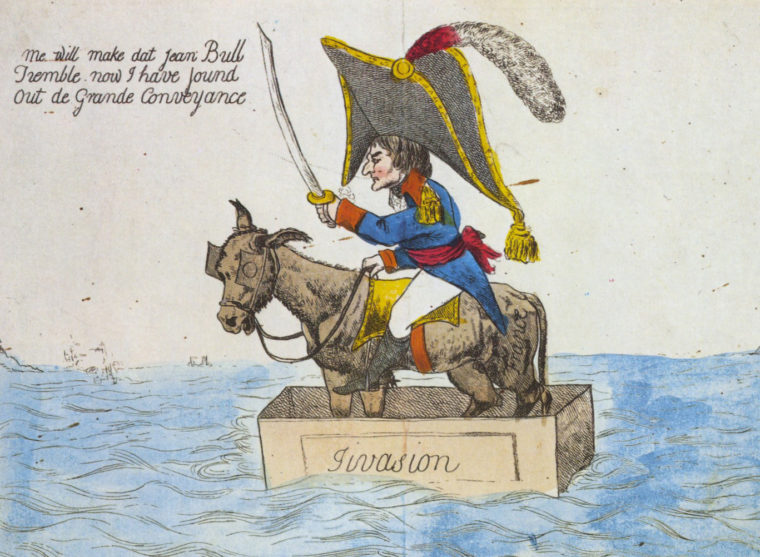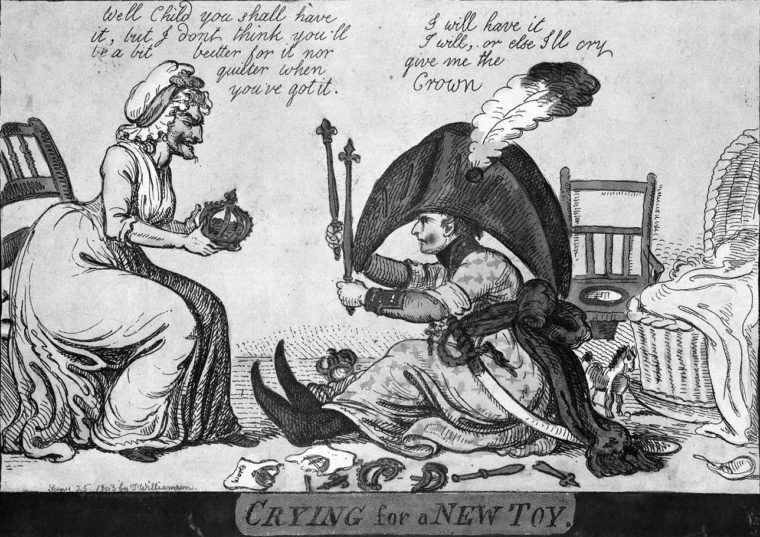
He was a brilliant strategist and a hero of the French Revolution. He conquered most of Europe. Laws he set down became a blueprint for modern civic law to replace feudal law. Yet the first thing that comes to mind when you the name Napoleon Bonaparte, is that he was short. We know that Napoleon was average height for a man of his time, but the myth of his height eclipse the truth so thoroughly that his name is permanently associated with small angry people. Why did this factoid tarnish his memory so completely? It may have been because Napoleon ran afoul of the pop-culture media of his day, the art of caricature and the fact that he gave the caricaturists of his time plenty of material to work with.
The Foundation of the Myth
 Napoleon Bonaparte was 5 foot 1 inch tall. He was also 5 foot 6 inches tall. He was 1.69 meters tall as well. All of these measurements are, or were, technically true. France and England had different standards for how long a ‘foot’ was. The French measurement of the foot was slightly larger than the English version. It would be an easy mistake to make and this might be the reason the English thought he was short. This is certainly reflected in English caricature, but strangely enough, he’s depicted as short by French caricature artists as well. In France, he was already seen as small and Napoleon’s own action would shrink him further as he went down in History.
Napoleon Bonaparte was 5 foot 1 inch tall. He was also 5 foot 6 inches tall. He was 1.69 meters tall as well. All of these measurements are, or were, technically true. France and England had different standards for how long a ‘foot’ was. The French measurement of the foot was slightly larger than the English version. It would be an easy mistake to make and this might be the reason the English thought he was short. This is certainly reflected in English caricature, but strangely enough, he’s depicted as short by French caricature artists as well. In France, he was already seen as small and Napoleon’s own action would shrink him further as he went down in History.
One of the biggest culprits for Napoleon’s legendary smallness may be his unfortunate nickname. When Napoleon was nine years old he was sent to military school to kick start his career. When he finished school he graduated as an artillery officer and saw action soon after. He quickly gained the respect of his subordinates. They called him “Le Petit Caporal” or “The Little Corporal” when translated into English. It was meant to be a term of endearment, ‘little’ probably being a reference to his young age rather than his height. The nickname dogged him throughout his life and was a frequent caption on many of the caricatures of him.
As Napoleon’s influence over Europe solidified, he married Joséphine, his first Empress. Joséphine was nearly as tall as Napoleon. Heels were as fashionable then as they are today. It was rumored that Napoleon asked her not to wear them so she wouldn’t appear taller than him. If this is true, he was already sensitive about his height, but that wasn’t the end of Napoleon’s contributions to the legend of his size.
Setting yourself up to be the Emperor of France and other countries is bound to make you a target for more than just satirical artists. Assassination was a very real concern for Napoleon. It was only natural that Napoleon surrounded himself with bodyguards and that they were near him at all times. His personal guard needed to be impressive and intimidating and so they were big men, taller than average. These men were with him at all times and he seemed small by comparison. Napoleon was dwarfed by his bodyguards and he dealt a self-inflicted blow to his height.
In addition to making himself appear physically shorter, he was also rumored to be petty and mean, particularly to women. Not only did he curtailed women’s rights in France and the rest of his empire, but he could be more personally insulting. He would frequently and intentionally spill food or ink on a woman’s clothes to ruin them. Why? Because he didn’t like how they were cut or how the looked on the lady. He personally policed women’s fashion. That’s pretty low, and caricaturists would never let him forget how low.
It’s true that there was a factual misunderstanding of how tall Napoleon Bonaparte really was.
However, the man himself was a huge contributor to the exaggeration of his underwhelming height. He was small for more reasons than his actual height. In part two of this article, we’ll explore how this myth proliferated through the art of caricature.

